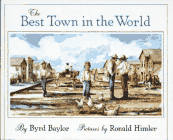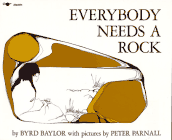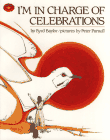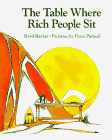Byrd Baylor - Author Study
![]()
Byrd Baylor was born in Texas in 1924 but now lives near Tucson, Arizona. She lives simply in an adobe house that she and some friends built. Her love of the desert began early and her mother often worried about the child who was so often content to roam the desert alone, watching and listening.

Most of her books have been inspired in the desert. When she found bits of ancient Indian pottery in the desert, she wrote When Clay Sings. After she went hunting for fossils, she wrote If You Are a Hunter of Fossils. Her father had told her about The Best Town in the World. She thinks of her books as her own private love song to her own part of the world.
Most of her books have very little plot and are lyrical descriptions of the life and beauty of the desert. Her respect for the environment and for native people is evident. Her prose suggests a certain philosophy: the spirit and not material things is what's necessary for personal growth and fulfillment.
Her collaboration with Peter Parnall is particularly apt. His dramatic lines illuminate the world of the desert and seem to echo its simplicity.
Things to Do:
Go through Baylor's books and find one or two lines that you especially like. Find photographs on the web or in magazines that you think would go well with those lines. Put them together on a poster.
Go through the Baylor books and list the plants and animals of the desert that she names. Find some animals and plants of the American deserts that are not mentioned. List them and find out more about them.
Books:
- Amigo - Illustrated by Garth Williams - Aladdin, 1963 (Order Info)
- Francisco is a lonely boy who wants a dog. When his father says they are too poor for a dog, Francisco's mother suggests something small and wild for a pet: a prairie dog. He has wonderful plans for its training and care and even names it Amigo before he finds it.
- The Best Town in the World - Illustrated by Ronald Himler - Scribners, 1982 (Order Info)
 This town in the Texas hills was called the Canyon as were all the ranches and farms around it. The narrator's father has told him all about it. The best cooks, dogs, chickens and everything else were to be found there. The summer lasted longest here and the people were the smartest, in spite of their unconventional spelling. This book was out of print as of February 2010 but is still widely available used or through libraries.
This town in the Texas hills was called the Canyon as were all the ranches and farms around it. The narrator's father has told him all about it. The best cooks, dogs, chickens and everything else were to be found there. The summer lasted longest here and the people were the smartest, in spite of their unconventional spelling. This book was out of print as of February 2010 but is still widely available used or through libraries.
- Scientific Method: Make a list of the claims in this book. Then take one of those claims and figure out how you could prove or disprove it.
- Exaggeration: Most of the statements in this book are exaggerated. Change them to make them more likely to be true. For instance: The dogs there were the smartest in the world - There were many smarts dogs in that town.
- Writing: Make a class book in which you exaggerate the wonders of the town where you live.
- Coyote Cry - Illustrated by Symeon Shimin - Lothrop, 1972 (Order Info)
- Antonio never forgets that coyote is his enemy. Grandfather makes excuses for coyote and claims he is their neighbor. As they tend the sheep in the hills, the man and boy are always alert to the sounds of the coyote so that they can protect the summer lambs. Blanca, the yellow collie, cannot help because of her four new pups. When a female coyote steals one of Blanca's pups, Antonio vows to get the thief. Finding the pup leads Antonio to an understanding of the coyote's song. This book was out of print as of February 2010 but is still widely available used or through libraries.
- The Desert Is Theirs - Aladdin, 1975 (Order Info)
- This is an introduction to many of the creatures who live in the desert. There is a ecological message here about each species' adaptation to the climate. The desert people chose a place where life would be hard. There Papago Indians shared the land with coyote, spider, lizard, buzzard, gopher, badger, deer, dove, rat and hawk. There is a feeling that all are brothers and desert creatures together.
- Desert Voices - Macmillan, 1980 (Order Info)
-
Each desert animal tells its story in prose that is very nearly poetry. Thus the animals of the desert are brought into focus and, viewing them all while we listen to their thoughts, we are given a look at the total desert environment.
- Animals, Defense Mechanisms: Make a list of the animals in this book. Beside each one put the things it uses to survive in the desert.
- Animals, Defense Mechanisms: Make a list similar to the one above but use animals that might be seen in the woods or fields nearest you.
- Food Chain: Cut out shapes of each of the animals in the book. Paste them on a larger paper in such a way as to show what each animal does for food.
- Senses: Go back to your list of animals in this book. Which senses or abilities are most important to each one?
- Point of View: Each animal in this book tells us about the desert from its point of view. What if one animal told us the whole thing? Try giving us the information from just the coyote's point of view.
- Everybody Needs a Rock - Macmillan, 1985 (Order Info)
 Of course they do! Here are ten carefully explained rules for choosing the absolutely perfect one for you. It must have exactly the right feel, color, texture and size. The specifications will make you smile, but they should also cause you to look a little closer at even the rocks in your driveway. You may even want to list ten ways for choosing a shell, a leaf or a friend. Read a longer review.
Of course they do! Here are ten carefully explained rules for choosing the absolutely perfect one for you. It must have exactly the right feel, color, texture and size. The specifications will make you smile, but they should also cause you to look a little closer at even the rocks in your driveway. You may even want to list ten ways for choosing a shell, a leaf or a friend. Read a longer review.
- Rocks and Minerals, Classifying, Sets: Start a classroom rock and mineral collection. Each morning, have someone sort the rocks into at least three groups and explain what the sets have in common.
- Writing: If there are ten rules for choosing the perfect rock, there can be ten rules for choosing other things like shells, leaves, friends, paintings, and the like. Make up ten rules for choosing something worth having.
- Guess Who My Favorite Person Is - Harper, 1985 (Order Info)
- Two friends make a game of choosing favorite sounds, sights and feelings. By making detailed choices, the friends in the book force the reader into thinking about specific things which cause joy in his or her own special view. In Parker's illustrations they are man and child, but it could be any two people who meet, play a game of favorites, and become friends during a brief afternoon together. Read a longer review.
- Hawk, I'm Your Brother- Scribner, 1976 (Order Info)
- Rudo, an Indian boy, wants to fly with the hawks. His first word was "flying" and he often asked, "When do I fly?" He knows the hawks intimately and steals a young one from its aerie. He tries in vain to tame the hawk who only screams at him. Finally, he realizes that he must let the hawk go to fly with the other young hawks. On his release, the hawk cries to Rudy who, in his mind, is also flying.
- If You Are a Hunter of Fossils - Macmillan, 1984 (Order Info)
- This book could be an introduction to paleontology as it shows how secrets of past life can be revealed in the rocks. Millions of years have passed since the desert was an ocean, but the fossils tell its story. Hunters can be found searching a Kansas wheat field or on a grey ledge in Utah. Everywhere hunters are reading the rocks and uncovering mysteries. This book was out of print as of February 2010 but is still widely available used or through libraries.
- I'm In Charge of Celebrations - Macmillan, 1986 (Order Info)
 Celebrations Indeed! Not the celebrations most of us celebrate, but moments of desert beauty to be celebrated: dust devils, rainbows, coyotes and clouds. A young girl wanders through the desert and shows you things worthy of your notice. This book makes you stop and look around you for your own celebrations. Read a longer review.
Celebrations Indeed! Not the celebrations most of us celebrate, but moments of desert beauty to be celebrated: dust devils, rainbows, coyotes and clouds. A young girl wanders through the desert and shows you things worthy of your notice. This book makes you stop and look around you for your own celebrations. Read a longer review.
- Comparing Personal Experience: Imagine yourself in a natural area nearby. Someone asks you what you could celebrate. What would be on your list of celebrations?
- Vocabulary, Gathering Data: List the celebration days that the narrator in the book lists. Find out as much as you can about the things that cause these events. Does anything like that happen in your area? Why not?
- Senses: Some of the events in the book the narrator sees, others she feels, smells or hears. Go back through the events and, if the narrator doesn't list the use of one of the senses for that event, think of something for which she could use one of the senses.
- One Small Blue Bead Illustrated by Ronald Himler - Atheneum, 1992 (Order Info)
- A boy whose prehistoric tribe believes they are the only people on earth is intrigued by the quest of an old man who searches for proof of other human life. Eventually he brings back another boy who clutches a small blue bead as proof.
- The Other Way to Listen - Scribners, 1978 (Order Info)
- The sound of corn singing and of wildflower seeds bursting open are sounds most people never hear. But if you listen to a sky full of stars or to a cactus blooming in the dark, you can hear it. You have to know how, of course. Here an old man shares his secrets with a child. First you must get to know one thing as well as you can but it's best to start with something very small.
- The Table Where Rich People Sit Illustrated by Peter Parnall - Aladdin, 1998 (Order Info)
 Seated at a homemade kitchen table, a little girl has called a meeting of her family, living simply in the desert. She thinks that they should find a way to make more money. Since she is fond of list-making, her mother and father suggest that she make a list of the things they think show their wealth: being able to work outside, for instance. They express the amount of money they think each thing is worth. Eventually, they have reached very large sums and the lesson is learned. Read a longer review.
Seated at a homemade kitchen table, a little girl has called a meeting of her family, living simply in the desert. She thinks that they should find a way to make more money. Since she is fond of list-making, her mother and father suggest that she make a list of the things they think show their wealth: being able to work outside, for instance. They express the amount of money they think each thing is worth. Eventually, they have reached very large sums and the lesson is learned. Read a longer review.
- Computation: The text of the book lists things the family thinks are important and gives a sum of money for each. Some of the things aren't listed however. Find things that could be on the list to equal the sum of four million and sixty thousand dollars.
- Comparing Personal Experience: Make up your own personal list of things of value to you and your family that don't cost money. Can you make your list as long as the narrator in the book does? Are there any things on both lists?
- The Way to Start a Day - Scribner, 1976 (Order Info)
- The way to start the day is to greet the sun with some kind of blessing, chant or song. When you feel the sun, you'll feel the song as well. Others have done it from the beginning of time: from cavemen to the present day. The Indians of North America greeted the Great Spirit. Over the Ganges River, the people of India greet the sun also. If you have a ceremony of your own with which to begin the day, "you'll be one more person in one more place, at one more time in the world."
- We Walk in Sandy Places - Scribners, 1976 (Order Info)
- The sand of the desert bears signs of the life that passes through it. Close up sepia photographs show us their intriguing tracks and the creatures who made them. This book was out of print as of February 2010 but is available used or through libraries.
- When Clay Sings - Illustrated by Tom Bahti - Aladdin, 1972 (Order Info)
- Indian children in the desert uncover pieces of the pottery created by their ancestors which celebrate the life of the desert. Their elders teach them to regard such remnants with respect and the children learn to listen to the song the pottery sings.
- Creative Art, Art Appreciation: Find images on the page either in words or pictures that you think are the most interesting. Make some designs using those patterns.
- Creative Art: Use clay to create pottery. Decorate it with some of the designs from the book.
- Finding Detail, Creative Art: Cut from construction paper a variety of pottery shapes. Make a class mural of these shapes and use phrases from the book to add to the mural.
- Native Americans, History, Research: Find out more about the ancient pottery makers of the American Southwest.
- Your Own Best Secret Place - Scribner, 1979 (Order Info)
- William Cottonwood used to live by the Rio Grande River in a valley in New Mexico. His secret place has been discovered by accident. A young child enters the place, a hollow in the foot of a cottonwood tree, and finds a blue blanket, a red coffee can and three notes nailed to the tree. There are other secret places described by the young intruder who sits in William's place and remembers other best secret hideaways. This book was out of print as of February 2010 but is available used or through libraries.
![]()
Related Areas of Carol Hurst's Children's Literature Site
- Featured Subject: Deserts through Kids Books with activities, related books and links.
- More Author Studies
- Author Studies in the classroom. General books and activities for any author.
Advertisement:
Advertisement:
Advertisement:

